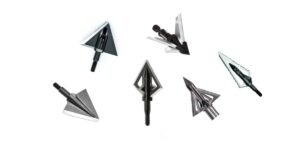Most hunters are well aware of the value associated with locating and identifying deer sign. Whether actively hunting or simply scouting, uncovering deer sign is a promising discovery. Scrapes, rubs, and even fresh tracks all serve as valuable sign to any hunter on a scout trip. However, many hunters overlook the value of locating and identifying deer scat or droppings.

Deer droppings serve as an indisputable indicator that deer have recently been present in a given area. This type of sign can also clue a hunter into the diet of the deer in a particular area and even, in some instances, a deer’s direction of travel.
Droppings could easily be considered one of the most important forms of sign left by whitetail. While a deer might not leave tracks in dry soil, and scrapes/rubs tend to be seasonal in nature, all deer deposit droppings daily. Most of these droppings are easily distinguishable and can be dated according to freshness. The concentration of droppings in a particular area is also highly indicative of the frequency with which deer regularly inhabit and use the area.
Buck Vs. Doe: Is There A Difference?
Many hunters have often been told by others that the size and shape of deer droppings often serve as a reliable indicator as to the sex of the deer that deposited them. Wisdom of this type is often recited around campfires, or while staring at a large pile, by hunters young and old alike, but is it true?
According to science, this just doesn’t stand up to reality. In fact, the exact diet of the deer within a particular area actually has far more to do with the scat’s characteristics than the gender of the deer in question. Generally speaking, firm pelletized droppings indicate a high concentration of acorns, woody plant matter, and grain within a deer’s diet. Larger droppings of a lumpy consistency suggest that deer have been feeding heavily upon natural browse and grasses.
A mixture of droppings within a specific area indicates a more rounded, inclusive diet. The only discernible difference between buck and doe droppings tends to be in the number of feces left behind. Bucks tend to deposit more pellets in a single instance than a doe but this difference tends to be minimal at best. Suffice to say, this isn’t a reliable indicator. While does often drop between 45-60 pellets, buck tend to drop closer to 80.
Frequency
Another reason that droppings serve as valuable deer sign is that they tend to be relatively plentiful. This provides plenty of indication that deer are regularly frequenting an area, or traversing a specific trail. Generally speaking, most adult deer defecate an average of 10-15 times a day during the colder months of the year. This number can be significantly higher during the spring and summer.
This also allows hunters to quickly identify the presence of heavily used or frequently bedded areas. Deer will often rise and travel several yards from their beds before defecating, only to return to their beds shortly after. Matted foliage with numerous droppings nearby highly indicates a regularly utilized bed. A bare dirt bed like the following image is fantastic sign:

Aging Droppings
For the observant hunter, droppings can also provide clues as to how recently a deer used a particular area. This stems from the fact that deer droppings tend to slightly change color and consistency over time. Droppings that appear dark and somewhat moist are likely less than a day old, while those appearing lighter in color or dry tend to be significantly older. Take a stick or your boot and press into the scat to determine how hard or soft it is.
This information can prove useful when attempting to determine the frequency with which deer use a certain area. If only older droppings are present one could reckon that deer are using an area intermittently, while a mixture of both old and fresh droppings indicates more consistent use of an area.
Along the same lines, a hunter can determine how recently a deer has bedded in a certain area, by aging the droppings nearby. An abundance of fresh droppings would suggest that the bed in question is fresh, and has been used in the last 24 hours, while the presence of aging and decaying droppings would indicate to the contrary.
Characteristics of Deer Droppings
Size
Believe it or not, you’ll find fairly small scat from such sizable creatures, typically measuring merely 0.4 to 1.1 inch and containing copious compacted pellets per pile. Deer feces, also known as deer pellets, are generally oval in shape and brown in color.
These individual droppings can vary slightly in size but usually maintain the characteristic pellet shape and measure around an inch in diameter. As time passes, a pile of deer poop may change to a lighter color due to weathering and exposure to the elements and may shrink in diameter. This natural process can make animal droppings harder to identify, but if you’re familiar with the distinct look of deer pellets – their oval shape and relatively small size – you should do fine.

Texture
As you examine the texture of those mysterious droppings, remember that a deer’s feces will have a shiny and smooth appearance when fresh. This is because deer thoroughly digest their food before expelling it as waste, resulting in animal waste that has a unique texture compared to other animals.
Deer droppings can be found in piles of scat consisting of small, round fecal pellets that are often shiny and moist when new. Here are three things to look for when examining the texture:
- Shape: Fresh deer droppings typically take on the form of small, round brown pellets clustered together. The scat shape is easily recognizable due to its uniform appearance.
- Fecal pellet moisture: When fresh, these brown pellets will be moist and appear slightly shiny on the surface. On the other hand, older deer poop may appear dry or crumbly.
- Lump droppings: In some cases, lump droppings may also occur where multiple fecal pellets fuse into one larger mass due to moisture content.
Shape
Deer poop has a distinct shape that sets it apart from other animal feces. When you come across piles of poop in the woods, you may immediately think of rabbit droppings due to their similar size and appearance. However, there are key differences between piles of deer droppings and rabbit pellets.
Deer droppings are typically oval-shaped, with one end coming to a small point because the deer’s anal sphincter closes on the pellet as it passes through. These black pellets usually measure around half an inch long and are found in clusters or piles. While rabbit pellets share some similarities with deer scat, they tend to be more spherical, lack the pointed end seen in deer fecal matter, and are smaller (about the size of a pea).
Why are Deer Poop Pellets So Small?
The small pellets that makeup deer poop are usually only about half an inch in diameter and can be found scattered across forest floors or grassy areas where deer roam. Wildlife agencies often use these tiny droppings to determine population density and local herds’ overall health.
One reason behind the small size of deer poop is that their food sources vary throughout the year, especially during summer when they consume a large amount of leaves and other foliage, which requires less digestion. Another contributing factor to why deer poop appears as small pellets is their natural inclination for heavy cover to avoid predators and minimize human exposure.
By excreting smaller droppings, it lessens the chances for direct contact with potential threats such as hunters or other animals who may smell their presence. This characteristic also makes it easier for decomposition, which helps keep habitats clean and healthy.
Deer Produce a Lot of Scat
Deer can produce a lot of poop, which is partly due to their herbivorous diet consisting of primarily leaves, twigs, fruits, and nuts. White-tailed deer are opportunistic feeders and will adapt their diet based on the availability of food in their habitat.
As they graze throughout the day, they’re constantly consuming large amounts of plant material that their digestive system must then process. How much you may ask? Well, consider these numbers:
- On average, adult deer defecate 13 times per day.
- Each bowel movement produces anywhere from 25 to 100 pellets.
- This means an individual deer can produce up to 1,300 pellets daily!
- Over a year, one deer’s scat production can add up to nearly half a million pellets.
Loose Droppings
When deer have looser scat, it can mean they’ve been consuming a lot of water-rich foods. This can include plants like clover, alfalfa, and other lush vegetation that provide plenty of moisture. Loose droppings can also be a sign that the deer has been feeding on fruits such as apples or berries.
These foods are high in water content and can cause the droppings to become less firm. While loose droppings may be nasty looking, it doesn’t necessarily indicate any health issues with the deer itself. It could be a parasite, but it could just be increased water content in their diet.
The Risks of Contact with Deer Droppings
While it’s true that analyzing deer poop can give you valuable insights into their behavior and diet, touching or handling their feces may expose you to various bacteria, viruses, and parasites. Some common pathogens in deer droppings include E. coli, Salmonella, Giardia, and Cryptosporidium.
These can cause serious gastrointestinal illnesses in humans if ingested. Always wear gloves and wash your hands thoroughly afterward to minimize risks when examining deer droppings. If you’re out in the field without access to soap and water, use hand sanitizer as an alternative until you can properly clean your hands. Avoid touching your face or eating food until you’ve cleaned up to ensure no harmful germs enter your body.







